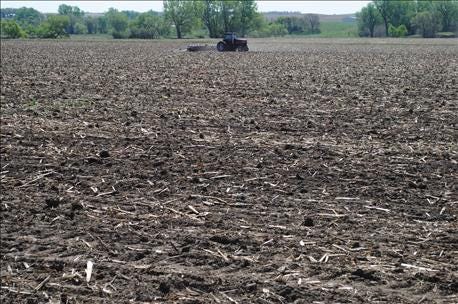
Over the past month, I’ve been fighting my fair share of lower back pain. Because much of my job these days has to do with sitting at a computer or in a car seat traveling to meetings or interviews, I’m just not up and about as much as I should be or would like to be these days. I’m admittedly not in the same shape as I was when I was fixing fence, pitching hay and chasing cows around the pasture full time. And, I’m experiencing the impact of that lack of exercise, because after being less physically active than I used to be, I still expect to do all the same things I did when I was actively farming whenever I want. That is my mistake.

HOURS IN THE SEAT: One of the main culprits for lower back pain in farmers is the tractor seat.
Last spring, I wrote an article about how to prevent lower back pain for farmers. I interviewed Rod Peterson, rural rehabilitation specialist with Nebraska AgrAbility. Since 1995, Nebraska AgrAbility has been helping producers with health related issues and disabilities to promote independence and success in their operations and rural life. The project offers professional training, on-farm assessments, technical assistance and information, as well as referrals to other service providers, all with the main goal to help farmers do their jobs with success. Farmers using the program may suffer from such limitations as amputations, hearing impairments, stroke, cancer and diabetes to back injuries, respiratory problems and orthopedic injuries.
“Back pain and back injuries are first or second on the list of disabilities we deal with,” Peterson told me in the interview. “Farmers get in a hurry. They don’t ask for help to lift and they often don’t use their skidloader and try to lift things by themselves.”
Peterson says that lifting is not the only cause of back injuries. Tractor and implement seats can often be the culprit. “Replace those old tractor seats,” Peterson advises. “We often see tractor seats that don’t have foam and support left. And farmers spend eight to 10 hours a day in these seats.” He also suggests taking time to adjust the tractor or combine seats properly, making sure the height and distance from the controls are correct, the armrests are adjusted and the posture and back supports are in a good position. “Make sure the seat is supporting your lower back and shoulder blades,” he says. “Make sure the seat is in position so you don’t have to stretch to reach the brake and clutch pedals. Good tractor seats and proper adjustment could probably solve a lot of farmer back pain.”
Related: Farm youth need good safety guardians
Peterson also suggests changing position in the tractor seat. “We tell our clients to change position in the seat once an hour,” he says. “Even if you don’t have an injury, it’s a good idea to get out of the tractor to check the equipment every hour. Do some stretches and get back in. Don’t sit there for 12 hours without moving around.”
Peterson reminds farmers to exit the tractor properly, facing the cab as they step down and using the handrails for balance. “Don’t get in a hurry,” he says. “Injuries happen when you get in a hurry and do something you wouldn’t normally do.”
Partnering with University of Nebraska Extension and Easter Seals Nebraska, Nebraska AgrAbility is headquartered in Hastings. If you’d like to be smarter than I’ve been lately and prevent lower back pain before it hits you, contact the AgrAbility office toll free at 800-471-6425. For a brochure on daily stretching routines and safe lifting techniques for farmers, download information at the Nebraska AgrAbility website at agrability.unl.edu. You can also find a report on proper lifting techniques, “Back on the Farm, Back in the Saddle,” at the National AgrAbility website at agrability.org.
Be sure to follow local farm news at Nebraska Farme online or by checking out our Facebook page.
About the Author(s)
You May Also Like






